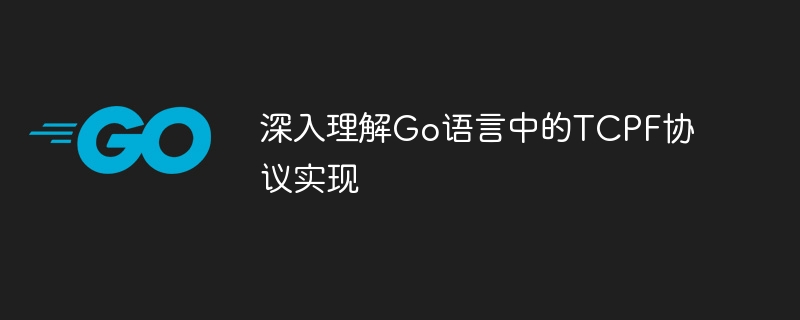 Backend Development
Backend Development
 Golang
Golang
 In-depth understanding of TCPF protocol implementation in Go language
In-depth understanding of TCPF protocol implementation in Go language
In-depth understanding of TCPF protocol implementation in Go language

Sorry, I can't provide you with a specific code example. But I can provide you with a draft article about in-depth understanding of the TCP protocol implementation in Go language. Please check it out:
With the rapid development of the Internet, network communication protocols play an important role in software development. important role. TCP (Transmission Control Protocol), as a reliable transmission control protocol, is widely used in network communications. In the Go language, we can use the built-in net package to implement TCP protocol communication. This article will delve into the implementation principles of the TCP protocol in the Go language and demonstrate some basic TCP communication examples.
Introduction to TCP protocol
TCP protocol is a connection-oriented protocol. It establishes a connection through a three-way handshake to ensure reliable transmission of data. In Go language, you can use the net package to easily create TCP connections and communicate. Here is an example of a simple TCP client:
package main
import (
"fmt"
"net"
)
func main() {
conn, err := net.Dial("tcp", "example.com:80")
if err != nil {
fmt.Println("Error connecting:", err)
return
}
defer conn.Close()
// 发送数据
conn.Write([]byte("Hello, TCP Server!"))
// 接收数据
buffer := make([]byte, 1024)
conn.Read(buffer)
fmt.Println("Received:", string(buffer))
}TCP server implementation
Writing a TCP server in Go language is also very simple. The following is an example of a simple TCP server:
package main
import (
"fmt"
"net"
)
func handleConnection(conn net.Conn) {
buffer := make([]byte, 1024)
_, err := conn.Read(buffer)
if err != nil {
fmt.Println("Error reading:", err)
return
}
fmt.Println("Received:", string(buffer))
conn.Write([]byte("Hello, TCP Client!"))
conn.Close()
}
func main() {
listener, err := net.Listen("tcp", ":8080")
if err != nil {
fmt.Println("Error listening:", err)
return
}
defer listener.Close()
fmt.Println("Server is listening on port 8080...")
for {
conn, err := listener.Accept()
if err != nil {
fmt.Println("Error accepting connection:", err)
return
}
go handleConnection(conn)
}
}Through the above code example, we can see how to implement a simple TCP server in the Go language and handle client connections and communications.
Summary
Through the introduction of this article, we have an in-depth understanding of the implementation principles of the TCP protocol in the Go language and demonstrated basic TCP communication examples. As a reliable transmission control protocol, the TCP protocol plays a vital role in network communication. We can easily implement TCP communication using the built-in net package of the Go language. I hope this article will be helpful to you, and everyone is welcome to learn and explore deeper knowledge of network communication protocols.
Hope this draft is helpful to you. If you need more information or specific code examples, please feel free to let me know.
The above is the detailed content of In-depth understanding of TCPF protocol implementation in Go language. For more information, please follow other related articles on the PHP Chinese website!

Hot AI Tools

Undresser.AI Undress
AI-powered app for creating realistic nude photos

AI Clothes Remover
Online AI tool for removing clothes from photos.

Undress AI Tool
Undress images for free

Clothoff.io
AI clothes remover

AI Hentai Generator
Generate AI Hentai for free.

Hot Article

Hot Tools

Notepad++7.3.1
Easy-to-use and free code editor

SublimeText3 Chinese version
Chinese version, very easy to use

Zend Studio 13.0.1
Powerful PHP integrated development environment

Dreamweaver CS6
Visual web development tools

SublimeText3 Mac version
God-level code editing software (SublimeText3)

Hot Topics
 How to use reflection to access private fields and methods in golang
May 03, 2024 pm 12:15 PM
How to use reflection to access private fields and methods in golang
May 03, 2024 pm 12:15 PM
How to use reflection to access private fields and methods in golang
 Tips for dynamically creating new functions in golang functions
Apr 25, 2024 pm 02:39 PM
Tips for dynamically creating new functions in golang functions
Apr 25, 2024 pm 02:39 PM
Tips for dynamically creating new functions in golang functions
 The difference between performance testing and unit testing in Go language
May 08, 2024 pm 03:09 PM
The difference between performance testing and unit testing in Go language
May 08, 2024 pm 03:09 PM
The difference between performance testing and unit testing in Go language
 What pitfalls should we pay attention to when designing distributed systems with Golang technology?
May 07, 2024 pm 12:39 PM
What pitfalls should we pay attention to when designing distributed systems with Golang technology?
May 07, 2024 pm 12:39 PM
What pitfalls should we pay attention to when designing distributed systems with Golang technology?
 Golang technology libraries and tools used in machine learning
May 08, 2024 pm 09:42 PM
Golang technology libraries and tools used in machine learning
May 08, 2024 pm 09:42 PM
Golang technology libraries and tools used in machine learning
 The role of Golang technology in mobile IoT development
May 09, 2024 pm 03:51 PM
The role of Golang technology in mobile IoT development
May 09, 2024 pm 03:51 PM
The role of Golang technology in mobile IoT development
 The evolution of golang function naming convention
May 01, 2024 pm 03:24 PM
The evolution of golang function naming convention
May 01, 2024 pm 03:24 PM
The evolution of golang function naming convention
 Can golang variable parameters be used for function return values?
Apr 29, 2024 am 11:33 AM
Can golang variable parameters be used for function return values?
Apr 29, 2024 am 11:33 AM
Can golang variable parameters be used for function return values?





